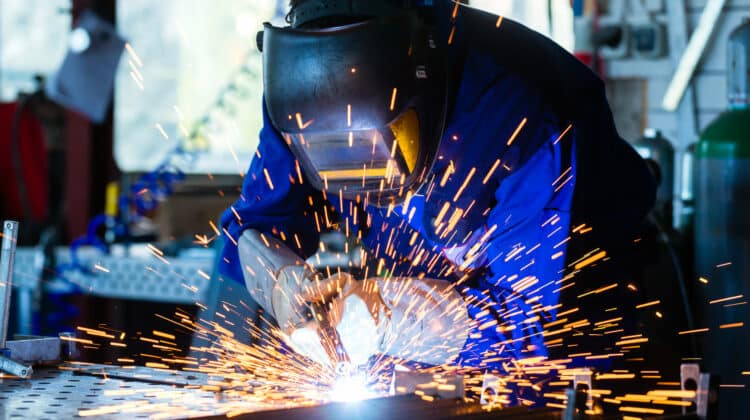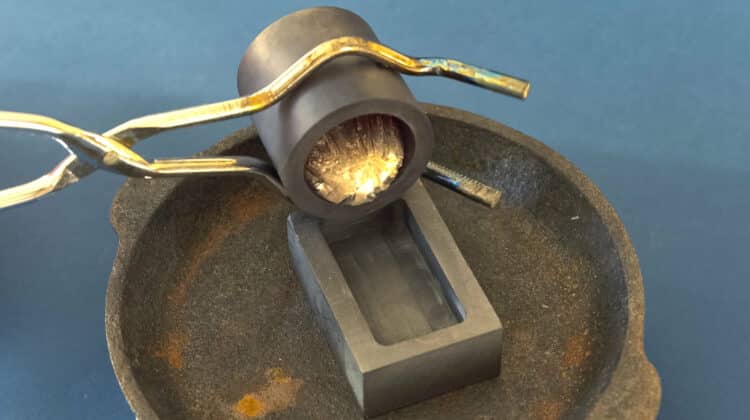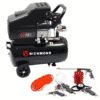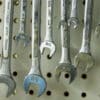How does thermite welding work in practical terms? Thermite welding can be defined as a welding method where heat is created during a chemical reaction, and this chemical reaction takes place as a result of the difference of free energy between aluminum and metal oxide.
The chemical reaction which generates the heat is described as aluminothermic reaction. This reaction produces a molten metal which works as a filler metal and joins metals on solidification. The thermite welding method is also referred to as exothermic welding or exothermic bonding or thermite welding.
It was invented by Hans Goldschmidt in 1898. It is a method of friction-based joining that does not require the use of flux, previously cleaned or prepared surfaces.
In thermite welding, no external energy, filler metal, or current is required during the welding process. Regardless of the pressure or absence of it, thermite welding will take place.
Thermite welding is quite a simple and easy approach. It is not time-consuming in comparison to other metal joining methods such as brazing.
Aside from welding, thermite is also used for boring or metal cutting, high-temperature ignition field-expedient, metal repairs, disabling military equipment, science demonstration, and others.
To generate a stable burn-in thermite reaction or thermite welding, it is important to get the right balance of fuel and oxidizer. This is a key factor in a thermite reaction.
Table of Contents
How thermite welding works
In thermite welding, the reaction takes place by the oxidation of a metal oxide, aluminum powder, and metallic fuel to execute an exothermic reaction.
To initiate the procedure, the thermite mixture must be preheated to about 1300°C. As a result, a temperature of 3000°C may be achieved.
The primary stage in the thermite reaction is the burning of thermite, which is a mixture of two substances: aluminum powder (metal oxide) and iron (III) oxide in a ratio of 1:3 in terms of weight and a small amount of water.
A mix of the two substances will generate heat without any spark or flame required. This reaction then generates enough heat to melt the metals and allow solidifying to create a permanent strong weld.
The chemical reaction continues until all the aluminum burns off and all-metal fuel has been used up.
Thermite reactions are of two different types and both can be used in welding metals. These include gasless welding and ignited welding.
The gasless welding makes use of magnesium as fuel and its metal oxide is either aluminum powder or zinc powder. Gasless welding as the name implies does not require the presence of air or oxygen for sustenance.
The ignited welding on the other hand has been in existence for a long time and required a small amount of air or oxygen to sustain itself. This type of thermite reaction is done using metal fuel and aluminum oxide.
Major parts of thermite welding
Some of the major parts of thermite welding include:
- Crucible — The crucible holds the thermite material during the thermite welding process. It has a taping device that discharges molten metal into the mold for the welding procedure. The crucible is able to withstand very high temperatures and the exothermic process takes place here.
- Thermite mixture — This is the chemical composition of aluminum powder, metal oxide, and fuel.
- Mold — During the thermite welding process, the mold holds the molten metal which is used for joining the metal. It is made up of a runner, slag basin, heating gate, and riser. The mold is created around the part to be welded
- Taping device — It is used to pour molten from the crucible into the mold.
Advantages of thermite welding
Some advantages of thermite welding include:
- Thermite welding is a fast method of welding two similar or dissimilar conductive materials
- There is no need for an external power source. This makes it quite economical.
- The process of thermite welding is quite simple and easy to carry out.
- It requires little money t to set-up
- Thermite welding can take place at sites where casting is impossible.
- Weld in thermit welding is created at high mechanical resistance and high corrosion resistance in comparison with other types
- It is very steady and allows for repeated short circuit pulses and even after a lifetime of the installation, the electrical resistance remains the same.
Disadvantages of thermite welding
While there are some advantages of thermite welding, there are also some drawbacks including:
- Compared to other welding processes, thermite welding is more expensive.
- When working outdoors and the weather condition is bad, you cannot use the thermite welding process.
- Grain structure and distortions of meldment may occur due to high temperatures.
- Welding rate in thermite welding is slow and may contain a gas such as hydrogen and a slag inclusion.
- Providing replaceable mold is required in the thermite welding process.
- Light metal and cheap metal fusion are not very budget-friendly.
- Thermite welding can only be done on ferrous parts such as steel, chromium, nickel.
Application of thermite welding
Thermite welding has been a traditional process of fusion used for welding thick material and heavy plates. It is a choice welding method for joining thick steel sections, pipes, railroads.
Thermite welding is also used in repairing heavy casting and gears. It is quite useful to weld copper welding cables and it is an ideal model to weld large sections such as locomotive rails, hull, ships.
Is it safe to use thermite welding?
When carried out with proper care and adequate knowledge, the thermite welding procedure is quite safe. However, it shouldn’t be done by persons who are untrained in the field and lack experience.
It also shouldn’t be attempted using unrefined metal like recycled metal or aluminum dross. Using thermite welding on hollow tube parts or on materials that can not be painted with molten metal during the procedure is out of the question.
Reactions from thermite welding can result in corneal burns. It generates fumes which can be irritating and dangerous.
While conducting the procedure, if your eyes get irritated by these fumes, wash your eyes with enough water continuously for a minimum of 15 minutes. Lift your eyelid from time to time. This should help take out the fumes.
Why choose thermite welding?
There are numerous reasons that make thermite welding an ideal choice for metal joining.
Generally, thermite welding is not time-consuming. It is an easy and quick technique when compared to other metal welding methods. In thermite welding, there is no need to prep the surfaces for any reason. This makes it a much simpler procedure.
In addition, it is a friction-based joining that doesn’t need any flux. Air or oxygen is also not required in the process of thermite welding making it an eco-friendly technique. This is because the aluminum powder will combust with just a little flame. Thermite welding is commonly used in welding railroad rails.
Why is only aluminum used for thermite welding?
In thermite welding, aluminum is used because it generates a great amount of heat and also reduces iron. It is used alongside ferric oxide.
By nature, aluminum has a special connection with oxygen and during welding, it reacts with ferric oxide to produce a reduced elemental molten iron. The elemental molten iron produced will seal the broken parts to create an even stronger and more stable bond.
Does thermite burn underwater?
Yes, thermite burns even underwater. This is as a result of a strategic combination of iron oxide rust and aluminum powder which requires a high temperature of a hot burning strip of magnesium for it to be ignited.
Once this happens, it is almost impossible to quench the fire. The heat becomes so excessive that it runs through the engine blocks and the pavement.
As a result of the extreme ferocity of the heat, the thermite will be able to remain alive underwater.
Is thermite explosive?
In the real sense, thermite isn’t explosive. However, some varieties can cause short bursts of heat and very high temperatures in a small area. This is because thermite is the pyrotechnic formation of metal powder and metal oxide which when stimulated by heat or a form of chemical reaction will undergo a redox reaction (Exothermic reduction-oxidation).





